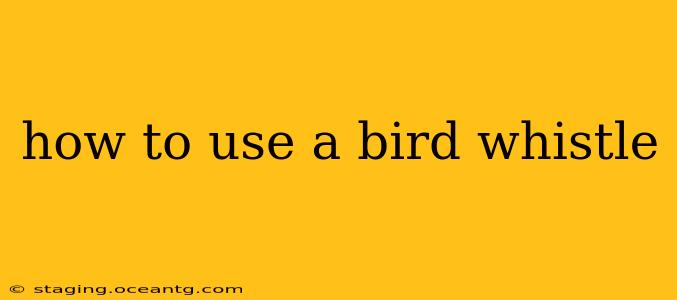Bird whistles, simple yet effective tools, offer a unique way to connect with the avian world. Whether you're a seasoned birder or a curious beginner, learning how to use a bird whistle effectively can significantly enhance your birdwatching experiences. This guide will cover everything from choosing the right whistle to mastering the techniques for attracting birds.
What Types of Bird Whistles Are There?
Before diving into techniques, let's understand the different types of bird whistles available. The most common are:
- Acoustical Whistles: These mimic bird calls through varying air pressure and chamber design. They're versatile and often allow for adjustments in pitch.
- Electronic Whistles: These use electronics to produce more complex and realistic bird sounds, often with pre-programmed calls. They are typically louder and more versatile than acoustical whistles but require batteries.
The best type for you depends on your needs and preferences. Acoustical whistles are great for learning basic techniques and are generally more affordable. Electronic whistles offer more options but require a greater investment.
How to Make Sounds With a Bird Whistle?
This is the core of using a bird whistle effectively. The technique varies slightly depending on the whistle type.
Acoustical Whistles:
- Mouth Placement: Hold the whistle between your lips, slightly puckering them. Experiment with the angle to find the best sound.
- Air Control: Gently blow across the opening, varying the force of your breath to change the pitch and volume. Start softly and gradually increase the air pressure to produce a clearer sound.
- Practice: Practice consistently to develop your skill. Aim for a clear, consistent sound that's not too harsh or too soft.
Electronic Whistles:
- Familiarize Yourself with Controls: Understand your whistle's buttons, settings, and volume controls before using it in the field.
- Volume Control: Begin with a lower volume setting and gradually increase it as needed. Avoid overly loud sounds, which can startle birds.
- Bird Call Selection: Electronic whistles usually offer various bird calls. Choose calls relevant to the species you are trying to attract.
What Bird Calls Should I Use?
This is crucial for success. Using the wrong call can scare birds away. Consider these factors:
- Local Bird Species: Research the common bird species in your area and learn their calls. Focus on learning the calls of birds you're likely to encounter.
- Distress Calls: Avoid using distress calls unless you have a good reason and understand their implications. They can attract birds but also put them at risk.
- Contact Calls: Contact calls are generally safer options as they are less alarming. They signal the presence of other birds without indicating danger.
What Time of Day Is Best to Use a Bird Whistle?
The optimal time for using a bird whistle is during the early morning and late evening. These times are often associated with peak bird activity, making it more likely you'll attract birds. Avoid using whistles during midday when birds are typically less active.
Can Bird Whistles Harm Birds?
Used responsibly, bird whistles are unlikely to harm birds. However, excessive use or improper use of distress calls can cause unnecessary stress. Always prioritize the well-being of the birds.
How Often Should I Use a Bird Whistle?
Use bird whistles sparingly and in moderation. Short bursts of calls followed by periods of silence are more effective than prolonged whistling. Avoid overwhelming birds with excessive sound.
Where Is the Best Place to Use a Bird Whistle?
The best location depends on your goal. To attract birds to your yard, use it from a vantage point where birds can easily see you. Remember that natural sounds can mask the bird calls.
By following these tips and practicing regularly, you can master the art of using a bird whistle and significantly enhance your enjoyment of birdwatching. Remember, responsible and ethical use is paramount to ensuring the safety and well-being of the birds you wish to attract.
